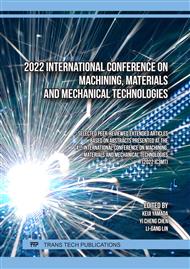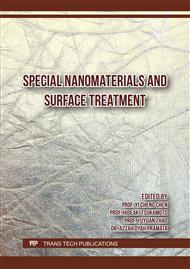p.3
p.15
p.25
p.33
p.41
p.49
p.61
p.69
Low Tool Wear Cutting Method Using H2O Radical
Abstract:
Tool wear is an important problem when cutting hard-to-cut materials such as stainless steel and nickel alloys. This unignorable disadvantage is caused by the diffusion of dissociated carbon atoms to the surface layer of the tool tip during the cutting process, and this has been confirmed by SEM/EDS analysis of worn tool tips. In this study, a novel cutting method is proposed in which chemically activated H2O molecules are introduced to the cutting tool tip in order to prevent tool wear by removing dissociated carbon atoms on the surface layer of the tool tip. In cutting experiments, stainless steel X5CrNi 18-10 (JIS SUS304), a cemented carbide tool tip, cutting oil, steam, and Ar plasma were used. Ar plasma was used for raising the steam temperature around the tool tip and chemically activating H2O molecules. From the results, the dissociated carbon and constituted knife edge were mostly removed by H2O steam and cutting oil without Ar plasma. However, in some cases using Ar plasma, the workpiece melted and tightly adhered to the cutting face of the tool tip. This suggests that the H2O steam temperature should be suitably controlled so as to remove carbon atoms effectively from the cutting face of the tool tip.
Info:
Periodical:
Pages:
15-23
Citation:
Online since:
December 2023
Authors:
Keywords:
Price:
Сopyright:
© 2023 Trans Tech Publications Ltd. All Rights Reserved
Share:
Citation:



